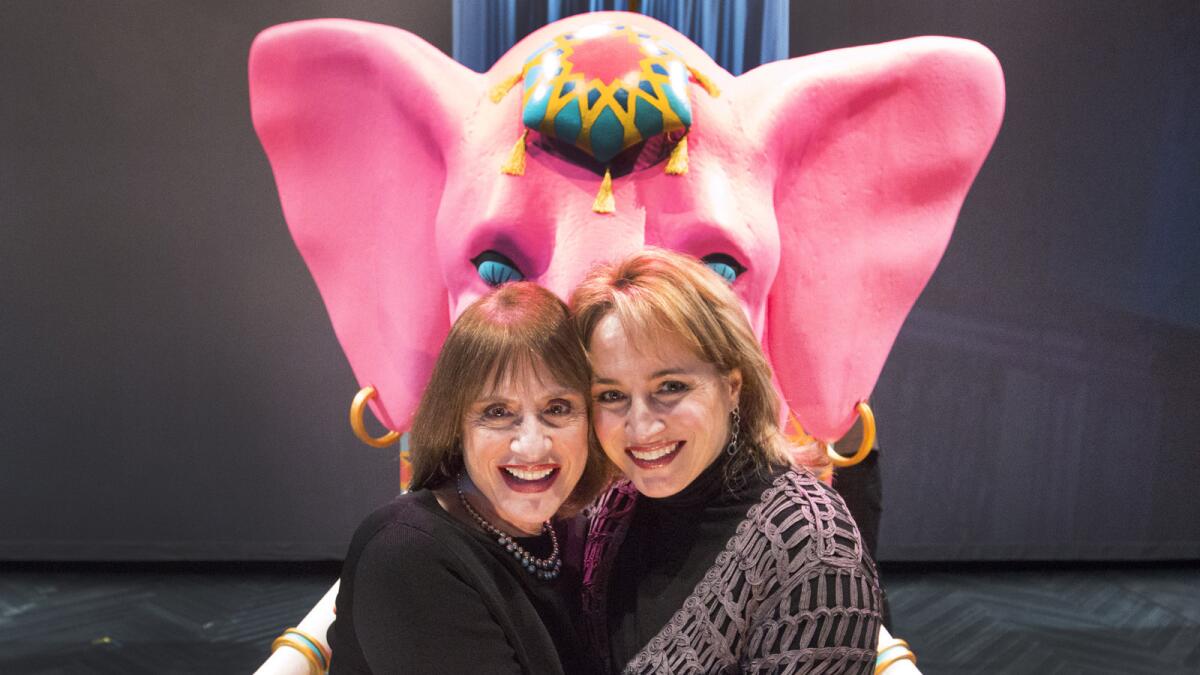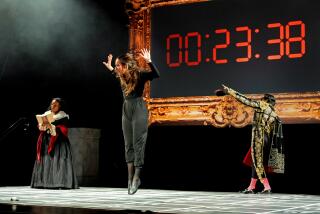L.A. Opera goes for the epic with ‘The Ghosts of Versailles’

In a large workshop at CBS Television City on the edge of Hollywood, the palace of Versailles was slowly taking shape.
A platoon of set builders was hard at work on a December morning creating the imposing columns, ornate tapestries and swooping staircases of the royal French chateau. In one corner, a series of nude decorative statues waited to be painted. On the other side of the studio, the curved elements of a domed ceiling sat in pieces amid sawdust and other construction detritus.
Many of the builders didn’t have much experience constructing Baroque architecture, having instead created sets for less refined endeavors such as “Survivor” and “The Price Is Right,” which tape just a few doors away.
But this simulacrum of Versailles wasn’t being created for television. Its final destination is at the Dorothy Chandler Pavilion, where it will serve as the set for Los Angeles Opera’s new production of John Corigliano’s “The Ghosts of Versailles.”
The size of the scenery required the opera to build it outside its facilities at the Music Center. “Ghosts” represents one of the company’s largest productions, with a cast of singers, dancers and acrobatic artists nearing 80 individuals. Epic in scale, alternately comic and tragic, with sexual bawdiness thrown in for good measure, “Ghosts” is an operatic behemoth by any measure — and a challenge to pull off artistically and logistically.
“It has a lot of moving parts and a lot of players. The tricky part is to get all those parts coordinated,” said soprano Patricia Racette, who plays the ghost of Marie Antoinette. “It sort of has a little bit of everything — or a lot of everything.”
“Ghosts” has seldom been seen in its full grandeur since it debuted at the Metropolitan Opera in New York in 1991. In that staging, Corigliano called for two orchestras — one in the pit and one onstage — but he later reduced it to a single orchestra and made cuts for a 1995 staging at the Lyric Opera of Chicago. The composer also approved a scaled-down chamber version that has been staged at smaller companies.
L.A. Opera’s production, which opens Feb. 7, features the fullest version of the score that currently exists — not quite as long as the Met premiere but substantially the same work, featuring a full orchestra, according to company leaders.
Darko Tresnjak, who won a Tony Award last year for directing the Broadway musical “A Gentleman’s Guide to Love & Murder,” is staging the new production with an eye for its comic and ghoulish elements.
“The first idea that came to me was the decapitated heads,” he said recently, referring to Marie Antoinette and other 18th century nobles who were guillotined during the French Revolution.
The principle ghost characters will be costumed to look like disembodied heads, while a series of doppelganger dancers will resemble headless bodies, following the singers in tandem around the chateau.
“Just the human traffic of the opera is daunting,” said Tresnjak, who spent more than a year doing research, including a trip to the real Versailles, where he studied the Petit Trianon, Marie Antoinette’s private palace.
“Ghosts” features a meta pretzel of a narrative in which the royal specters haunting Versailles observe an opera-within-an-opera written by Pierre de Beaumarchais, the real-life French playwright whose dramas inspired “The Marriage of Figaro” and “The Barber of Seville,” which L.A. Opera is also producing this season.
Eventually, characters from the ghost world and the interior opera start to intermingle as the plot escalates around a stolen necklace and the Reign of Terror.
Getting it right
During a rehearsal in January, Tresnjak was blocking a scene in the opera’s second act, in which several characters are thrown into prison and await execution. Over the course of an hour, he worked with the singers to fine-tune the scene’s mix of dread and camp humor, constantly adjusting gestures and scenery.
James Conlon, the company’s music director, was overseeing the sung passages. At one point, he told the cast members to trust their own judgment and not look at him during sections performed in a conversational sing-speak rhythm.
“If you have to wait for me to point all the time, it’s not going to be dramatic,” he told them.
Conlon later said during a break that the score was a deliberate mix of styles, ranging from quasi-neo-classical to more experimental 20th century. “It’s not atonal, and it’s not 100% anything,” he said.
The conductor recalled that in the ‘90s he had discussed with Corigliano the possibility of reviving “Ghosts” at the Paris National Opera, but nothing came of it. A planned Met revival five years ago was called off for budgetary reasons.
Reached by phone in New York, Corigliano said that he was looking forward to attending rehearsals in L.A. but that he was worried the recent East Coast blizzard would affect his flight.
“I need to be there. This piece uses many new notations, some of which are traditional and some of my own, and they have to be taught to the orchestra,” he said. “It puts the musicians on the level of students — they usually don’t like that, and it takes time. Once they learn, it’s much easier to play. But they have to learn these techniques.”
Corigliano is one of the most honored living American composers, having won a handful of Grammy Awards, a Pulitzer Prize in 2001 for his Symphony No. 2 and an Academy Award for his score to the 1999 movie “The Red Violin.”
The composer wrote “Ghosts” with librettist William Hoffman as a Met commission to mark the organization’s 100th anniversary, and it remains his only opera. At its 1991 premiere, the production received mixed notices, but it was a box-office success. The Met staging was taped for PBS and is available on DVD.
“I have a lot of affection for the piece,” Corigliano said, adding that he wrote it partly as an homage to one of his favorite genres — the opera buffa, the Italian phrase for comic opera. “Operas don’t usually give that kind of joy, and they’re very angst-filled. Buffa is about irreverence.”
One of the piece’s most outlandish scenes is a send-up of the 18th century mania for all things Turkish. In the Act 1 climax, set in the Turkish Embassy, Patti LuPone plays Samira, an exotic entertainer, in what is essentially a 10-minute cameo. Her grander-than-grand entrance is made on the back of a mechanical pink elephant.
“I call her Dumbo’s girlfriend,” LuPone said. The role was first played at the Met by Marilyn Horne and is intended to be a show-stopper for a diva.
LuPone, who appeared at L.A. Opera eight years ago in “Rise and Fall of the City of Mahagonny,” said she has always enjoyed playing second banana to the romantic lead because of the artistic freedom that often comes with it. “But in this opera, I’m like, ‘What, the eighth or ninth banana?’” she said with a laugh.
The Broadway veteran admitted that some elements of the opera’s convoluted plot continue to elude her: “I’m still not sure what happens to the necklace after my scene.”
“Ghosts” is expected to be a major undertaking financially for L.A. Opera. The company said the sets and costumes alone cost $1 million to create, but it didn’t divulge other expenditures, such as running costs or talent fees.
In a statement, Plácido Domingo, the company’s general director, called it “a vast and challenging undertaking for any opera company.”
A good part of the money for “Ghosts” is coming from a gift from the Ann and Gordon Getty Foundation. Gordon Getty, one of the sons of billionaire J. Paul Getty, is a composer in his own right as well as an opera fan. His representatives didn’t respond to requests for comment.
L.A. Opera said the donor had requested that the details of his gift remain private.
The foundation has supported L.A. Opera in other initiatives, including a recent $90,000 grant for audience development that it awarded through the New York-based Opera America, a nonprofit organization that promotes the art form throughout the country.
For major new productions of a scale like “Ghosts,” opera companies typically team to shoulder the financial burden. L.A. Opera hasn’t announced any producing partners, and it’s unclear whether the production will travel to other cities after the L.A. run concludes March 1.
For now, the focus is on getting the show up and running in a hectic rehearsal period of a little more than a month. The epic nature of the task is a challenge that Tresnjak, the director, seems to relish.
“The first play I directed had 30 people in the cast, and that was hard. The next play was six, and that was terrifying. The next was three — completely alarming,” he said. “We have close to 80 people onstage in this. This is what I’m comfortable doing.”
More to Read
The biggest entertainment stories
Get our big stories about Hollywood, film, television, music, arts, culture and more right in your inbox as soon as they publish.
You may occasionally receive promotional content from the Los Angeles Times.







